Dental Business Management: Ethics, Patient Protection & Conduct
VerifiedAdded on 2023/06/13
|9
|2810
|376
Report
AI Summary
This report provides a comprehensive overview of dental business management, emphasizing the critical roles of ethical standards, patient protection, and patient conduct in ensuring quality healthcare. It delves into the ethical codes set by the Australian Dental Board, highlighting professional values, beneficence, relationship building, risk minimization, and professional behavior. The report further explores patient protection through privacy, rights, safety, and risk management, aligning these with legal and ethical obligations. Finally, it discusses patient codes of conduct, focusing on professionalism, cultural safety, environmental safety, effective communication, and responsible information sharing, all essential for fostering a positive and effective dental practice. The document is available on Desklib, a platform offering various study tools and resources for students.
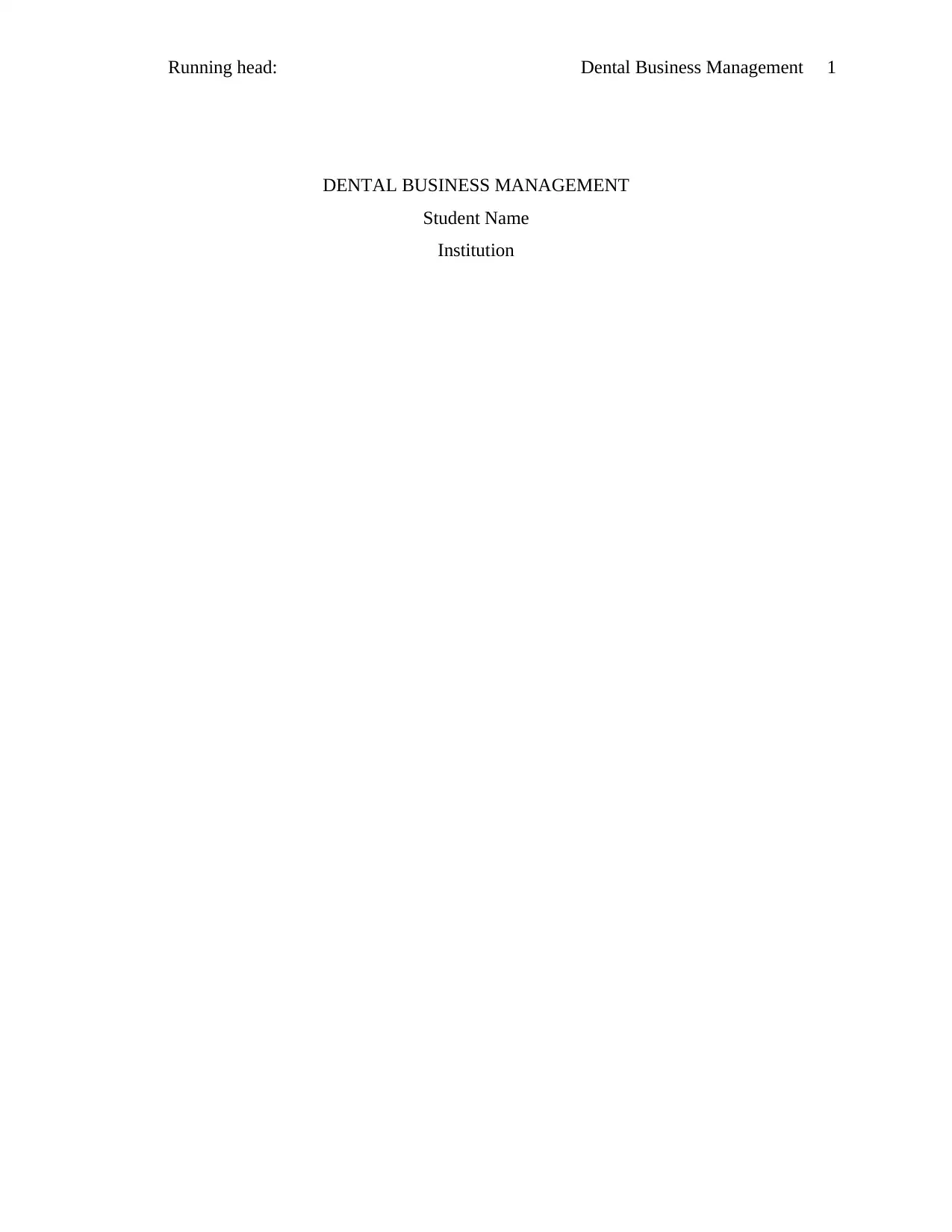
Running head: Dental Business Management 1
DENTAL BUSINESS MANAGEMENT
Student Name
Institution
DENTAL BUSINESS MANAGEMENT
Student Name
Institution
Paraphrase This Document
Need a fresh take? Get an instant paraphrase of this document with our AI Paraphraser
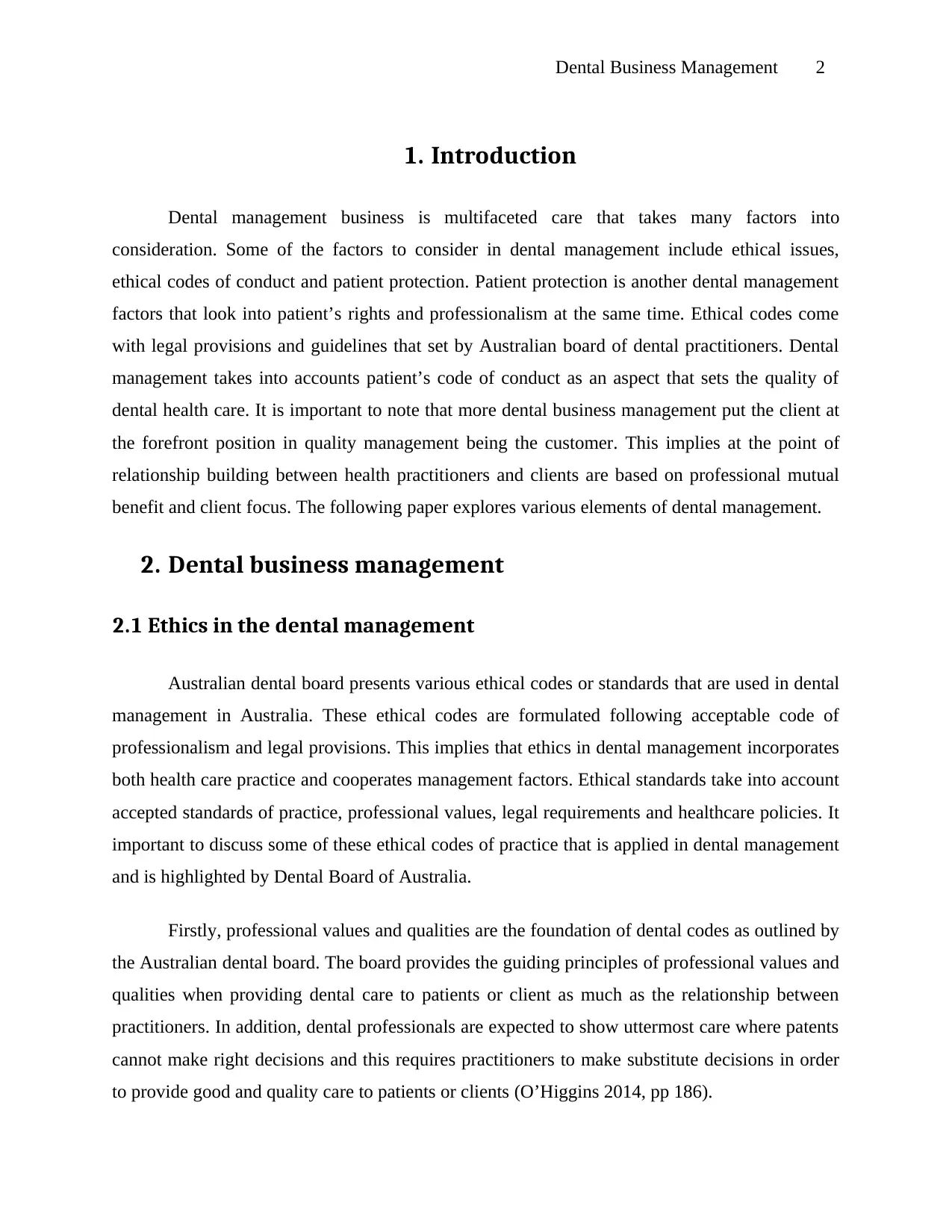
Dental Business Management 2
1. Introduction
Dental management business is multifaceted care that takes many factors into
consideration. Some of the factors to consider in dental management include ethical issues,
ethical codes of conduct and patient protection. Patient protection is another dental management
factors that look into patient’s rights and professionalism at the same time. Ethical codes come
with legal provisions and guidelines that set by Australian board of dental practitioners. Dental
management takes into accounts patient’s code of conduct as an aspect that sets the quality of
dental health care. It is important to note that more dental business management put the client at
the forefront position in quality management being the customer. This implies at the point of
relationship building between health practitioners and clients are based on professional mutual
benefit and client focus. The following paper explores various elements of dental management.
2. Dental business management
2.1 Ethics in the dental management
Australian dental board presents various ethical codes or standards that are used in dental
management in Australia. These ethical codes are formulated following acceptable code of
professionalism and legal provisions. This implies that ethics in dental management incorporates
both health care practice and cooperates management factors. Ethical standards take into account
accepted standards of practice, professional values, legal requirements and healthcare policies. It
important to discuss some of these ethical codes of practice that is applied in dental management
and is highlighted by Dental Board of Australia.
Firstly, professional values and qualities are the foundation of dental codes as outlined by
the Australian dental board. The board provides the guiding principles of professional values and
qualities when providing dental care to patients or client as much as the relationship between
practitioners. In addition, dental professionals are expected to show uttermost care where patents
cannot make right decisions and this requires practitioners to make substitute decisions in order
to provide good and quality care to patients or clients (O’Higgins 2014, pp 186).
1. Introduction
Dental management business is multifaceted care that takes many factors into
consideration. Some of the factors to consider in dental management include ethical issues,
ethical codes of conduct and patient protection. Patient protection is another dental management
factors that look into patient’s rights and professionalism at the same time. Ethical codes come
with legal provisions and guidelines that set by Australian board of dental practitioners. Dental
management takes into accounts patient’s code of conduct as an aspect that sets the quality of
dental health care. It is important to note that more dental business management put the client at
the forefront position in quality management being the customer. This implies at the point of
relationship building between health practitioners and clients are based on professional mutual
benefit and client focus. The following paper explores various elements of dental management.
2. Dental business management
2.1 Ethics in the dental management
Australian dental board presents various ethical codes or standards that are used in dental
management in Australia. These ethical codes are formulated following acceptable code of
professionalism and legal provisions. This implies that ethics in dental management incorporates
both health care practice and cooperates management factors. Ethical standards take into account
accepted standards of practice, professional values, legal requirements and healthcare policies. It
important to discuss some of these ethical codes of practice that is applied in dental management
and is highlighted by Dental Board of Australia.
Firstly, professional values and qualities are the foundation of dental codes as outlined by
the Australian dental board. The board provides the guiding principles of professional values and
qualities when providing dental care to patients or client as much as the relationship between
practitioners. In addition, dental professionals are expected to show uttermost care where patents
cannot make right decisions and this requires practitioners to make substitute decisions in order
to provide good and quality care to patients or clients (O’Higgins 2014, pp 186).
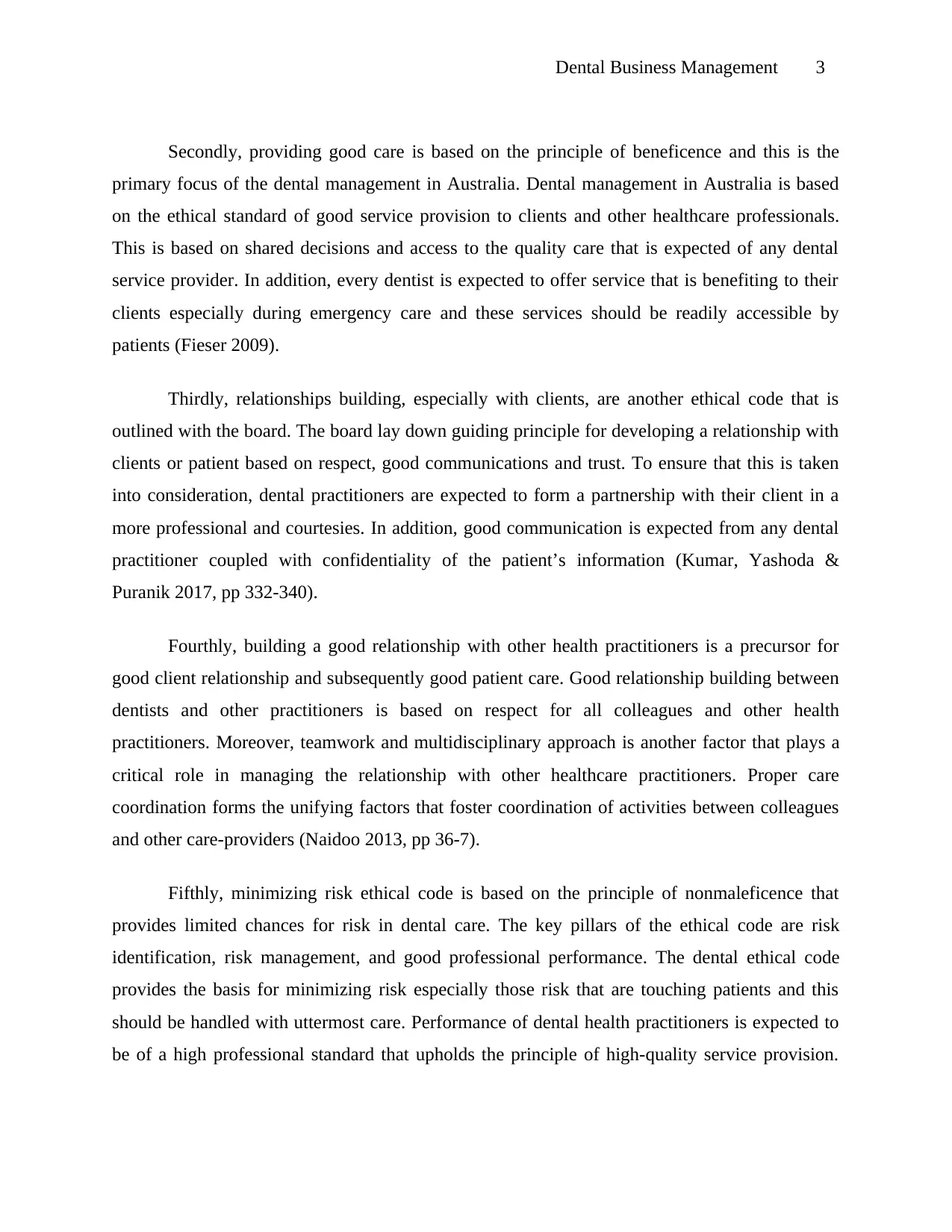
Dental Business Management 3
Secondly, providing good care is based on the principle of beneficence and this is the
primary focus of the dental management in Australia. Dental management in Australia is based
on the ethical standard of good service provision to clients and other healthcare professionals.
This is based on shared decisions and access to the quality care that is expected of any dental
service provider. In addition, every dentist is expected to offer service that is benefiting to their
clients especially during emergency care and these services should be readily accessible by
patients (Fieser 2009).
Thirdly, relationships building, especially with clients, are another ethical code that is
outlined with the board. The board lay down guiding principle for developing a relationship with
clients or patient based on respect, good communications and trust. To ensure that this is taken
into consideration, dental practitioners are expected to form a partnership with their client in a
more professional and courtesies. In addition, good communication is expected from any dental
practitioner coupled with confidentiality of the patient’s information (Kumar, Yashoda &
Puranik 2017, pp 332-340).
Fourthly, building a good relationship with other health practitioners is a precursor for
good client relationship and subsequently good patient care. Good relationship building between
dentists and other practitioners is based on respect for all colleagues and other health
practitioners. Moreover, teamwork and multidisciplinary approach is another factor that plays a
critical role in managing the relationship with other healthcare practitioners. Proper care
coordination forms the unifying factors that foster coordination of activities between colleagues
and other care-providers (Naidoo 2013, pp 36-7).
Fifthly, minimizing risk ethical code is based on the principle of nonmaleficence that
provides limited chances for risk in dental care. The key pillars of the ethical code are risk
identification, risk management, and good professional performance. The dental ethical code
provides the basis for minimizing risk especially those risk that are touching patients and this
should be handled with uttermost care. Performance of dental health practitioners is expected to
be of a high professional standard that upholds the principle of high-quality service provision.
Secondly, providing good care is based on the principle of beneficence and this is the
primary focus of the dental management in Australia. Dental management in Australia is based
on the ethical standard of good service provision to clients and other healthcare professionals.
This is based on shared decisions and access to the quality care that is expected of any dental
service provider. In addition, every dentist is expected to offer service that is benefiting to their
clients especially during emergency care and these services should be readily accessible by
patients (Fieser 2009).
Thirdly, relationships building, especially with clients, are another ethical code that is
outlined with the board. The board lay down guiding principle for developing a relationship with
clients or patient based on respect, good communications and trust. To ensure that this is taken
into consideration, dental practitioners are expected to form a partnership with their client in a
more professional and courtesies. In addition, good communication is expected from any dental
practitioner coupled with confidentiality of the patient’s information (Kumar, Yashoda &
Puranik 2017, pp 332-340).
Fourthly, building a good relationship with other health practitioners is a precursor for
good client relationship and subsequently good patient care. Good relationship building between
dentists and other practitioners is based on respect for all colleagues and other health
practitioners. Moreover, teamwork and multidisciplinary approach is another factor that plays a
critical role in managing the relationship with other healthcare practitioners. Proper care
coordination forms the unifying factors that foster coordination of activities between colleagues
and other care-providers (Naidoo 2013, pp 36-7).
Fifthly, minimizing risk ethical code is based on the principle of nonmaleficence that
provides limited chances for risk in dental care. The key pillars of the ethical code are risk
identification, risk management, and good professional performance. The dental ethical code
provides the basis for minimizing risk especially those risk that are touching patients and this
should be handled with uttermost care. Performance of dental health practitioners is expected to
be of a high professional standard that upholds the principle of high-quality service provision.
⊘ This is a preview!⊘
Do you want full access?
Subscribe today to unlock all pages.

Trusted by 1+ million students worldwide
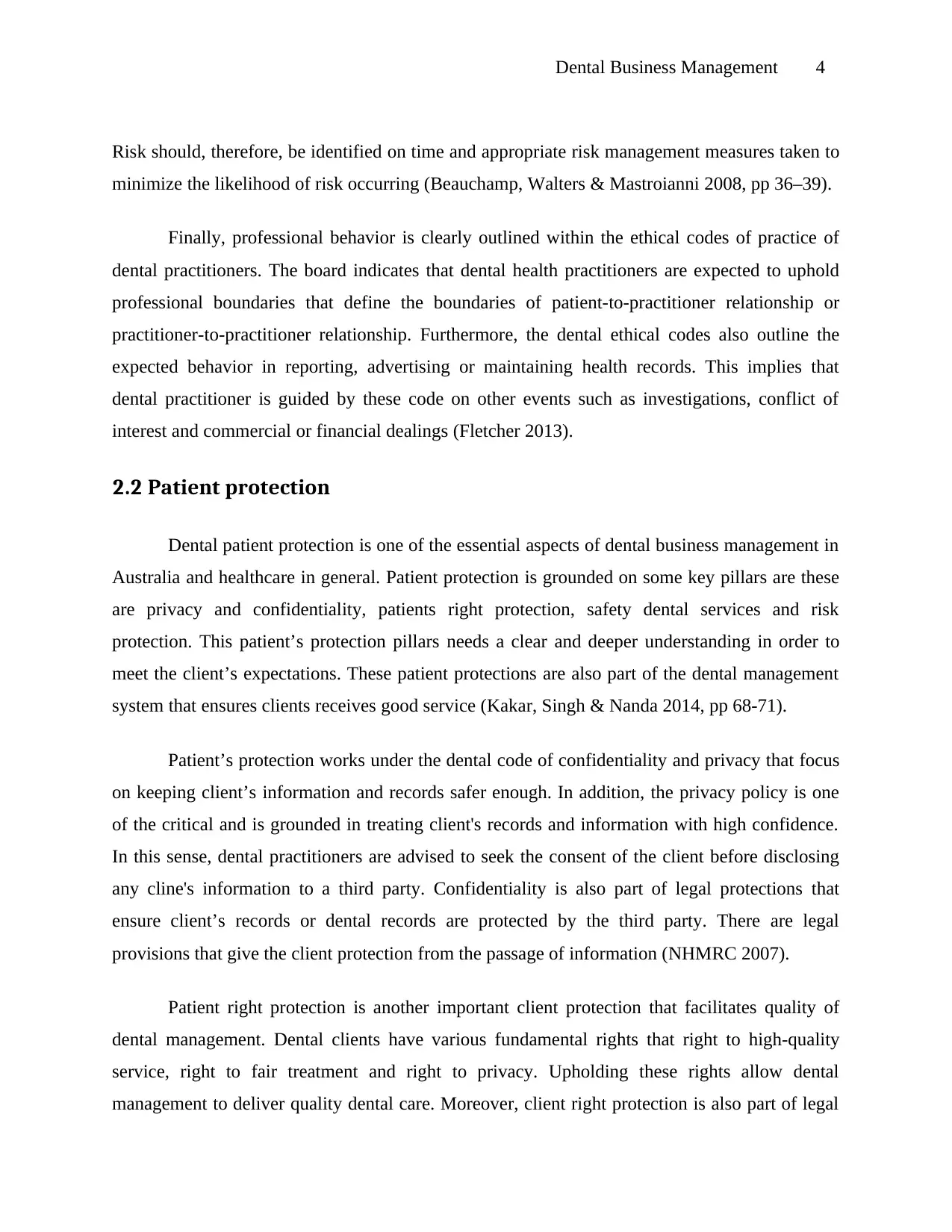
Dental Business Management 4
Risk should, therefore, be identified on time and appropriate risk management measures taken to
minimize the likelihood of risk occurring (Beauchamp, Walters & Mastroianni 2008, pp 36–39).
Finally, professional behavior is clearly outlined within the ethical codes of practice of
dental practitioners. The board indicates that dental health practitioners are expected to uphold
professional boundaries that define the boundaries of patient-to-practitioner relationship or
practitioner-to-practitioner relationship. Furthermore, the dental ethical codes also outline the
expected behavior in reporting, advertising or maintaining health records. This implies that
dental practitioner is guided by these code on other events such as investigations, conflict of
interest and commercial or financial dealings (Fletcher 2013).
2.2 Patient protection
Dental patient protection is one of the essential aspects of dental business management in
Australia and healthcare in general. Patient protection is grounded on some key pillars are these
are privacy and confidentiality, patients right protection, safety dental services and risk
protection. This patient’s protection pillars needs a clear and deeper understanding in order to
meet the client’s expectations. These patient protections are also part of the dental management
system that ensures clients receives good service (Kakar, Singh & Nanda 2014, pp 68-71).
Patient’s protection works under the dental code of confidentiality and privacy that focus
on keeping client’s information and records safer enough. In addition, the privacy policy is one
of the critical and is grounded in treating client's records and information with high confidence.
In this sense, dental practitioners are advised to seek the consent of the client before disclosing
any cline's information to a third party. Confidentiality is also part of legal protections that
ensure client’s records or dental records are protected by the third party. There are legal
provisions that give the client protection from the passage of information (NHMRC 2007).
Patient right protection is another important client protection that facilitates quality of
dental management. Dental clients have various fundamental rights that right to high-quality
service, right to fair treatment and right to privacy. Upholding these rights allow dental
management to deliver quality dental care. Moreover, client right protection is also part of legal
Risk should, therefore, be identified on time and appropriate risk management measures taken to
minimize the likelihood of risk occurring (Beauchamp, Walters & Mastroianni 2008, pp 36–39).
Finally, professional behavior is clearly outlined within the ethical codes of practice of
dental practitioners. The board indicates that dental health practitioners are expected to uphold
professional boundaries that define the boundaries of patient-to-practitioner relationship or
practitioner-to-practitioner relationship. Furthermore, the dental ethical codes also outline the
expected behavior in reporting, advertising or maintaining health records. This implies that
dental practitioner is guided by these code on other events such as investigations, conflict of
interest and commercial or financial dealings (Fletcher 2013).
2.2 Patient protection
Dental patient protection is one of the essential aspects of dental business management in
Australia and healthcare in general. Patient protection is grounded on some key pillars are these
are privacy and confidentiality, patients right protection, safety dental services and risk
protection. This patient’s protection pillars needs a clear and deeper understanding in order to
meet the client’s expectations. These patient protections are also part of the dental management
system that ensures clients receives good service (Kakar, Singh & Nanda 2014, pp 68-71).
Patient’s protection works under the dental code of confidentiality and privacy that focus
on keeping client’s information and records safer enough. In addition, the privacy policy is one
of the critical and is grounded in treating client's records and information with high confidence.
In this sense, dental practitioners are advised to seek the consent of the client before disclosing
any cline's information to a third party. Confidentiality is also part of legal protections that
ensure client’s records or dental records are protected by the third party. There are legal
provisions that give the client protection from the passage of information (NHMRC 2007).
Patient right protection is another important client protection that facilitates quality of
dental management. Dental clients have various fundamental rights that right to high-quality
service, right to fair treatment and right to privacy. Upholding these rights allow dental
management to deliver quality dental care. Moreover, client right protection is also part of legal
Paraphrase This Document
Need a fresh take? Get an instant paraphrase of this document with our AI Paraphraser
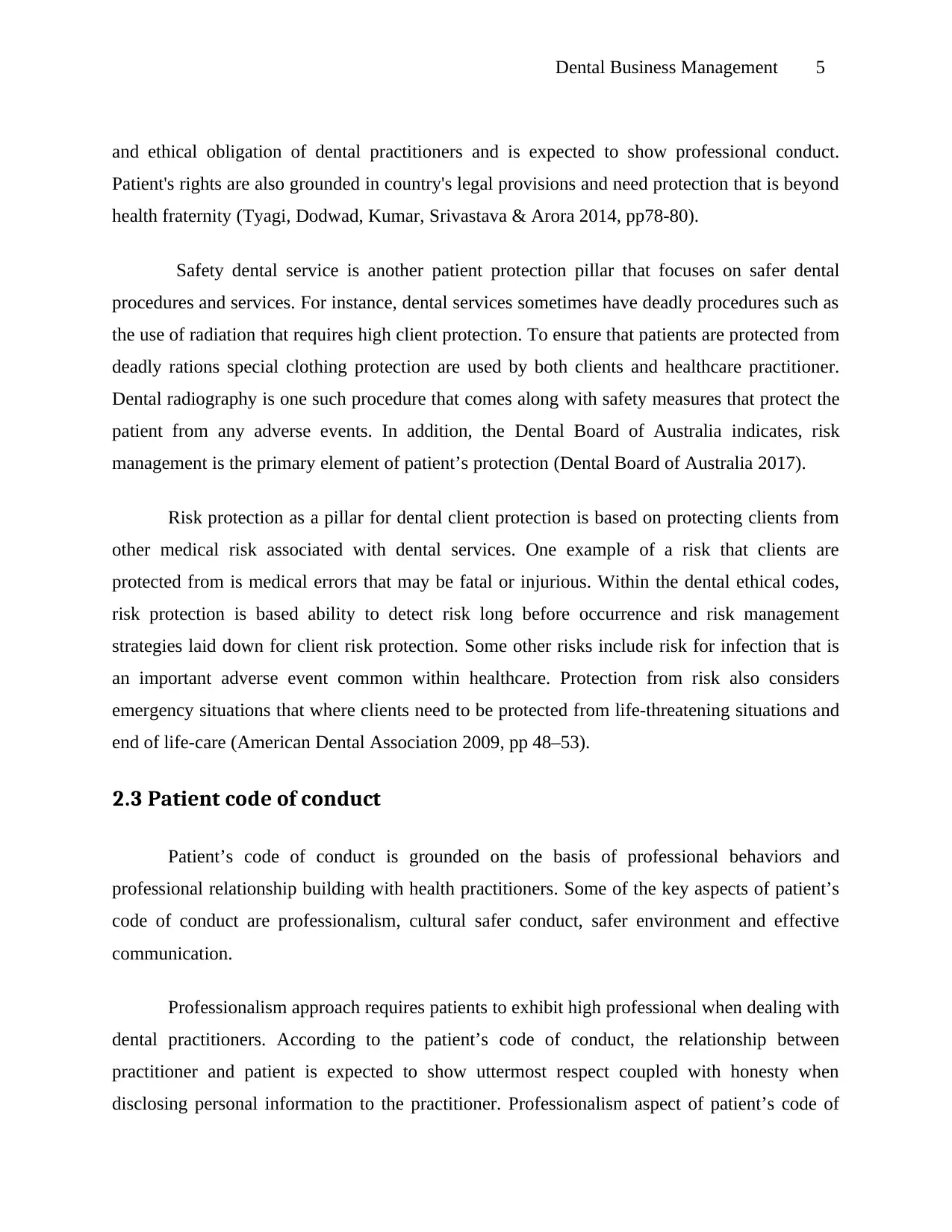
Dental Business Management 5
and ethical obligation of dental practitioners and is expected to show professional conduct.
Patient's rights are also grounded in country's legal provisions and need protection that is beyond
health fraternity (Tyagi, Dodwad, Kumar, Srivastava & Arora 2014, pp78-80).
Safety dental service is another patient protection pillar that focuses on safer dental
procedures and services. For instance, dental services sometimes have deadly procedures such as
the use of radiation that requires high client protection. To ensure that patients are protected from
deadly rations special clothing protection are used by both clients and healthcare practitioner.
Dental radiography is one such procedure that comes along with safety measures that protect the
patient from any adverse events. In addition, the Dental Board of Australia indicates, risk
management is the primary element of patient’s protection (Dental Board of Australia 2017).
Risk protection as a pillar for dental client protection is based on protecting clients from
other medical risk associated with dental services. One example of a risk that clients are
protected from is medical errors that may be fatal or injurious. Within the dental ethical codes,
risk protection is based ability to detect risk long before occurrence and risk management
strategies laid down for client risk protection. Some other risks include risk for infection that is
an important adverse event common within healthcare. Protection from risk also considers
emergency situations that where clients need to be protected from life-threatening situations and
end of life-care (American Dental Association 2009, pp 48–53).
2.3 Patient code of conduct
Patient’s code of conduct is grounded on the basis of professional behaviors and
professional relationship building with health practitioners. Some of the key aspects of patient’s
code of conduct are professionalism, cultural safer conduct, safer environment and effective
communication.
Professionalism approach requires patients to exhibit high professional when dealing with
dental practitioners. According to the patient’s code of conduct, the relationship between
practitioner and patient is expected to show uttermost respect coupled with honesty when
disclosing personal information to the practitioner. Professionalism aspect of patient’s code of
and ethical obligation of dental practitioners and is expected to show professional conduct.
Patient's rights are also grounded in country's legal provisions and need protection that is beyond
health fraternity (Tyagi, Dodwad, Kumar, Srivastava & Arora 2014, pp78-80).
Safety dental service is another patient protection pillar that focuses on safer dental
procedures and services. For instance, dental services sometimes have deadly procedures such as
the use of radiation that requires high client protection. To ensure that patients are protected from
deadly rations special clothing protection are used by both clients and healthcare practitioner.
Dental radiography is one such procedure that comes along with safety measures that protect the
patient from any adverse events. In addition, the Dental Board of Australia indicates, risk
management is the primary element of patient’s protection (Dental Board of Australia 2017).
Risk protection as a pillar for dental client protection is based on protecting clients from
other medical risk associated with dental services. One example of a risk that clients are
protected from is medical errors that may be fatal or injurious. Within the dental ethical codes,
risk protection is based ability to detect risk long before occurrence and risk management
strategies laid down for client risk protection. Some other risks include risk for infection that is
an important adverse event common within healthcare. Protection from risk also considers
emergency situations that where clients need to be protected from life-threatening situations and
end of life-care (American Dental Association 2009, pp 48–53).
2.3 Patient code of conduct
Patient’s code of conduct is grounded on the basis of professional behaviors and
professional relationship building with health practitioners. Some of the key aspects of patient’s
code of conduct are professionalism, cultural safer conduct, safer environment and effective
communication.
Professionalism approach requires patients to exhibit high professional when dealing with
dental practitioners. According to the patient’s code of conduct, the relationship between
practitioner and patient is expected to show uttermost respect coupled with honesty when
disclosing personal information to the practitioner. Professionalism aspect of patient’s code of
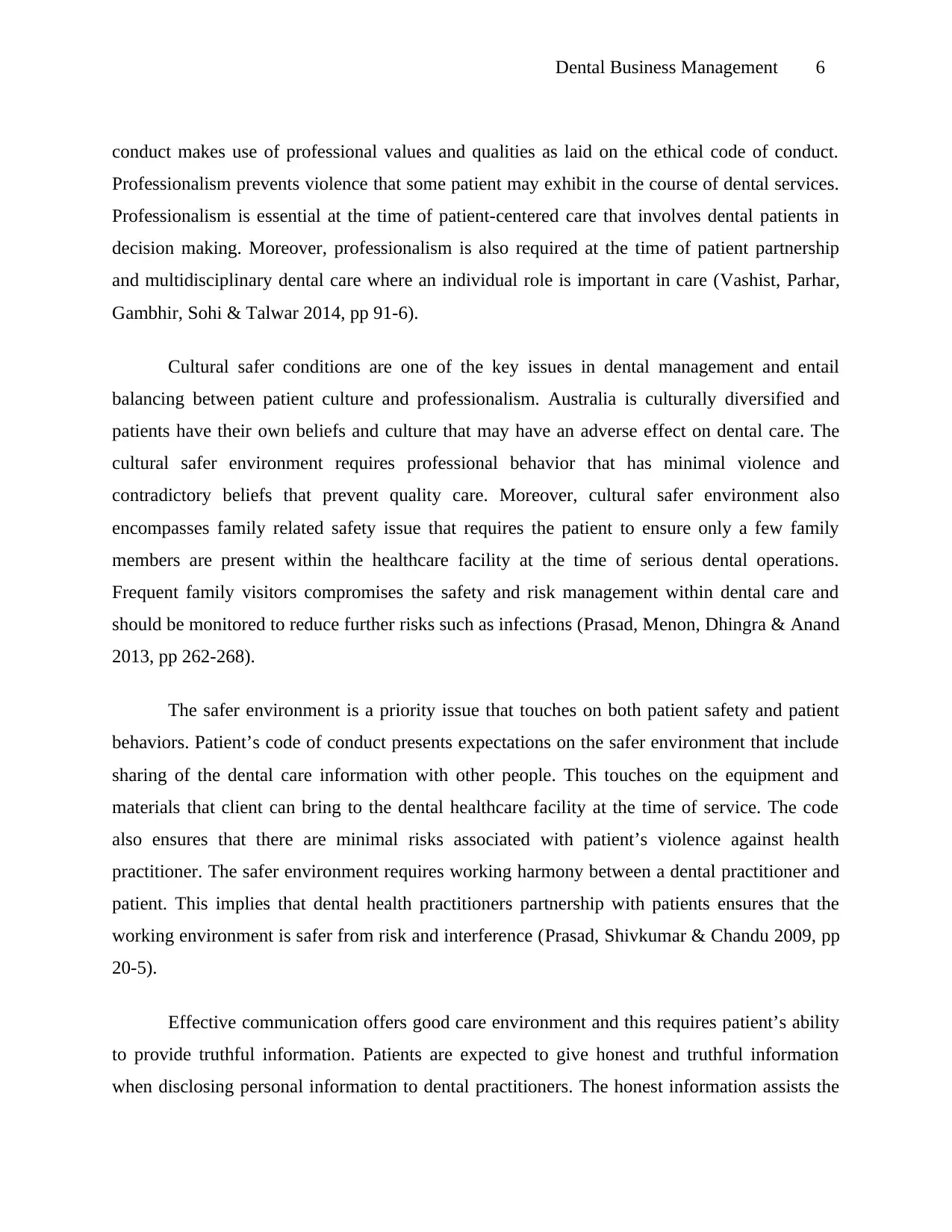
Dental Business Management 6
conduct makes use of professional values and qualities as laid on the ethical code of conduct.
Professionalism prevents violence that some patient may exhibit in the course of dental services.
Professionalism is essential at the time of patient-centered care that involves dental patients in
decision making. Moreover, professionalism is also required at the time of patient partnership
and multidisciplinary dental care where an individual role is important in care (Vashist, Parhar,
Gambhir, Sohi & Talwar 2014, pp 91-6).
Cultural safer conditions are one of the key issues in dental management and entail
balancing between patient culture and professionalism. Australia is culturally diversified and
patients have their own beliefs and culture that may have an adverse effect on dental care. The
cultural safer environment requires professional behavior that has minimal violence and
contradictory beliefs that prevent quality care. Moreover, cultural safer environment also
encompasses family related safety issue that requires the patient to ensure only a few family
members are present within the healthcare facility at the time of serious dental operations.
Frequent family visitors compromises the safety and risk management within dental care and
should be monitored to reduce further risks such as infections (Prasad, Menon, Dhingra & Anand
2013, pp 262-268).
The safer environment is a priority issue that touches on both patient safety and patient
behaviors. Patient’s code of conduct presents expectations on the safer environment that include
sharing of the dental care information with other people. This touches on the equipment and
materials that client can bring to the dental healthcare facility at the time of service. The code
also ensures that there are minimal risks associated with patient’s violence against health
practitioner. The safer environment requires working harmony between a dental practitioner and
patient. This implies that dental health practitioners partnership with patients ensures that the
working environment is safer from risk and interference (Prasad, Shivkumar & Chandu 2009, pp
20-5).
Effective communication offers good care environment and this requires patient’s ability
to provide truthful information. Patients are expected to give honest and truthful information
when disclosing personal information to dental practitioners. The honest information assists the
conduct makes use of professional values and qualities as laid on the ethical code of conduct.
Professionalism prevents violence that some patient may exhibit in the course of dental services.
Professionalism is essential at the time of patient-centered care that involves dental patients in
decision making. Moreover, professionalism is also required at the time of patient partnership
and multidisciplinary dental care where an individual role is important in care (Vashist, Parhar,
Gambhir, Sohi & Talwar 2014, pp 91-6).
Cultural safer conditions are one of the key issues in dental management and entail
balancing between patient culture and professionalism. Australia is culturally diversified and
patients have their own beliefs and culture that may have an adverse effect on dental care. The
cultural safer environment requires professional behavior that has minimal violence and
contradictory beliefs that prevent quality care. Moreover, cultural safer environment also
encompasses family related safety issue that requires the patient to ensure only a few family
members are present within the healthcare facility at the time of serious dental operations.
Frequent family visitors compromises the safety and risk management within dental care and
should be monitored to reduce further risks such as infections (Prasad, Menon, Dhingra & Anand
2013, pp 262-268).
The safer environment is a priority issue that touches on both patient safety and patient
behaviors. Patient’s code of conduct presents expectations on the safer environment that include
sharing of the dental care information with other people. This touches on the equipment and
materials that client can bring to the dental healthcare facility at the time of service. The code
also ensures that there are minimal risks associated with patient’s violence against health
practitioner. The safer environment requires working harmony between a dental practitioner and
patient. This implies that dental health practitioners partnership with patients ensures that the
working environment is safer from risk and interference (Prasad, Shivkumar & Chandu 2009, pp
20-5).
Effective communication offers good care environment and this requires patient’s ability
to provide truthful information. Patients are expected to give honest and truthful information
when disclosing personal information to dental practitioners. The honest information assists the
⊘ This is a preview!⊘
Do you want full access?
Subscribe today to unlock all pages.

Trusted by 1+ million students worldwide
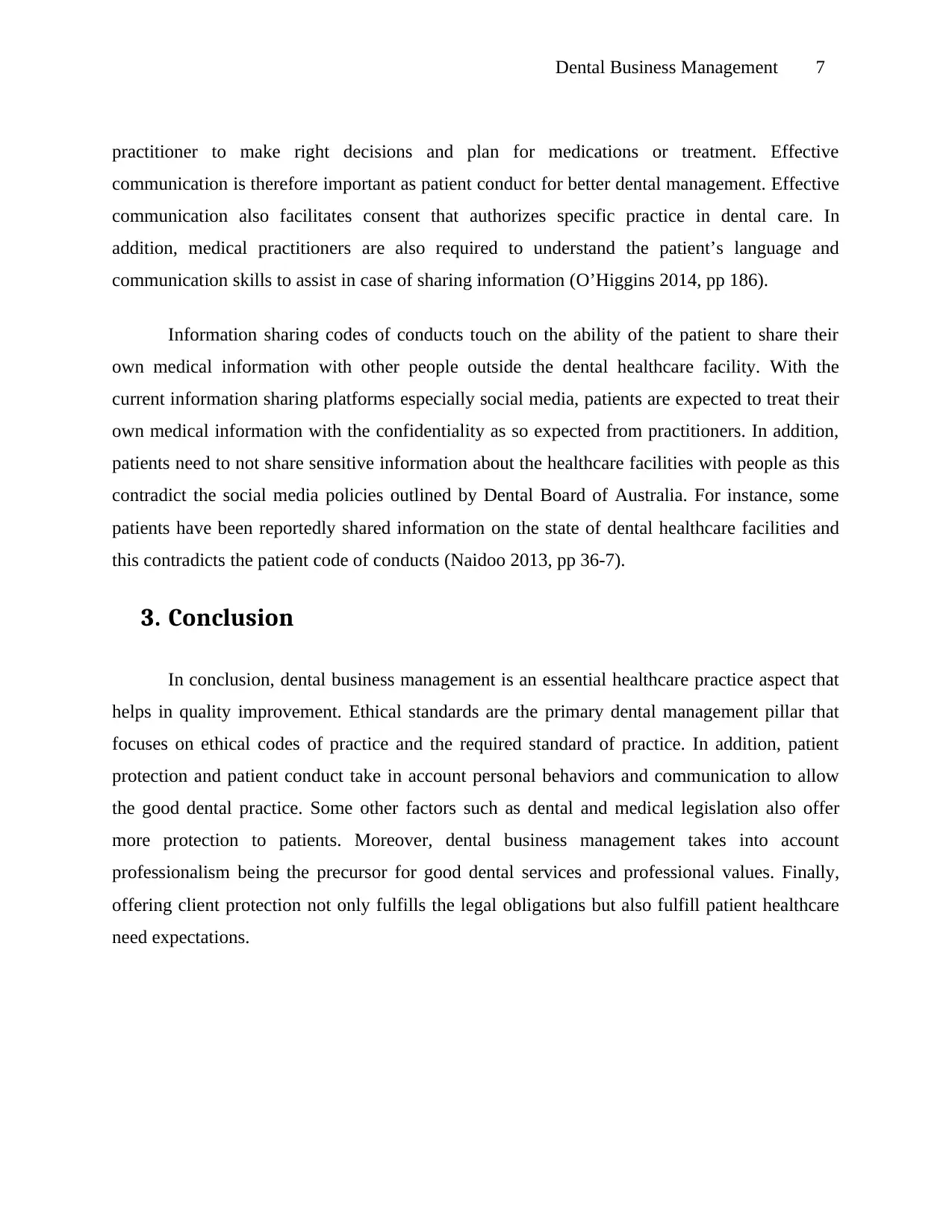
Dental Business Management 7
practitioner to make right decisions and plan for medications or treatment. Effective
communication is therefore important as patient conduct for better dental management. Effective
communication also facilitates consent that authorizes specific practice in dental care. In
addition, medical practitioners are also required to understand the patient’s language and
communication skills to assist in case of sharing information (O’Higgins 2014, pp 186).
Information sharing codes of conducts touch on the ability of the patient to share their
own medical information with other people outside the dental healthcare facility. With the
current information sharing platforms especially social media, patients are expected to treat their
own medical information with the confidentiality as so expected from practitioners. In addition,
patients need to not share sensitive information about the healthcare facilities with people as this
contradict the social media policies outlined by Dental Board of Australia. For instance, some
patients have been reportedly shared information on the state of dental healthcare facilities and
this contradicts the patient code of conducts (Naidoo 2013, pp 36-7).
3. Conclusion
In conclusion, dental business management is an essential healthcare practice aspect that
helps in quality improvement. Ethical standards are the primary dental management pillar that
focuses on ethical codes of practice and the required standard of practice. In addition, patient
protection and patient conduct take in account personal behaviors and communication to allow
the good dental practice. Some other factors such as dental and medical legislation also offer
more protection to patients. Moreover, dental business management takes into account
professionalism being the precursor for good dental services and professional values. Finally,
offering client protection not only fulfills the legal obligations but also fulfill patient healthcare
need expectations.
practitioner to make right decisions and plan for medications or treatment. Effective
communication is therefore important as patient conduct for better dental management. Effective
communication also facilitates consent that authorizes specific practice in dental care. In
addition, medical practitioners are also required to understand the patient’s language and
communication skills to assist in case of sharing information (O’Higgins 2014, pp 186).
Information sharing codes of conducts touch on the ability of the patient to share their
own medical information with other people outside the dental healthcare facility. With the
current information sharing platforms especially social media, patients are expected to treat their
own medical information with the confidentiality as so expected from practitioners. In addition,
patients need to not share sensitive information about the healthcare facilities with people as this
contradict the social media policies outlined by Dental Board of Australia. For instance, some
patients have been reportedly shared information on the state of dental healthcare facilities and
this contradicts the patient code of conducts (Naidoo 2013, pp 36-7).
3. Conclusion
In conclusion, dental business management is an essential healthcare practice aspect that
helps in quality improvement. Ethical standards are the primary dental management pillar that
focuses on ethical codes of practice and the required standard of practice. In addition, patient
protection and patient conduct take in account personal behaviors and communication to allow
the good dental practice. Some other factors such as dental and medical legislation also offer
more protection to patients. Moreover, dental business management takes into account
professionalism being the precursor for good dental services and professional values. Finally,
offering client protection not only fulfills the legal obligations but also fulfill patient healthcare
need expectations.
Paraphrase This Document
Need a fresh take? Get an instant paraphrase of this document with our AI Paraphraser
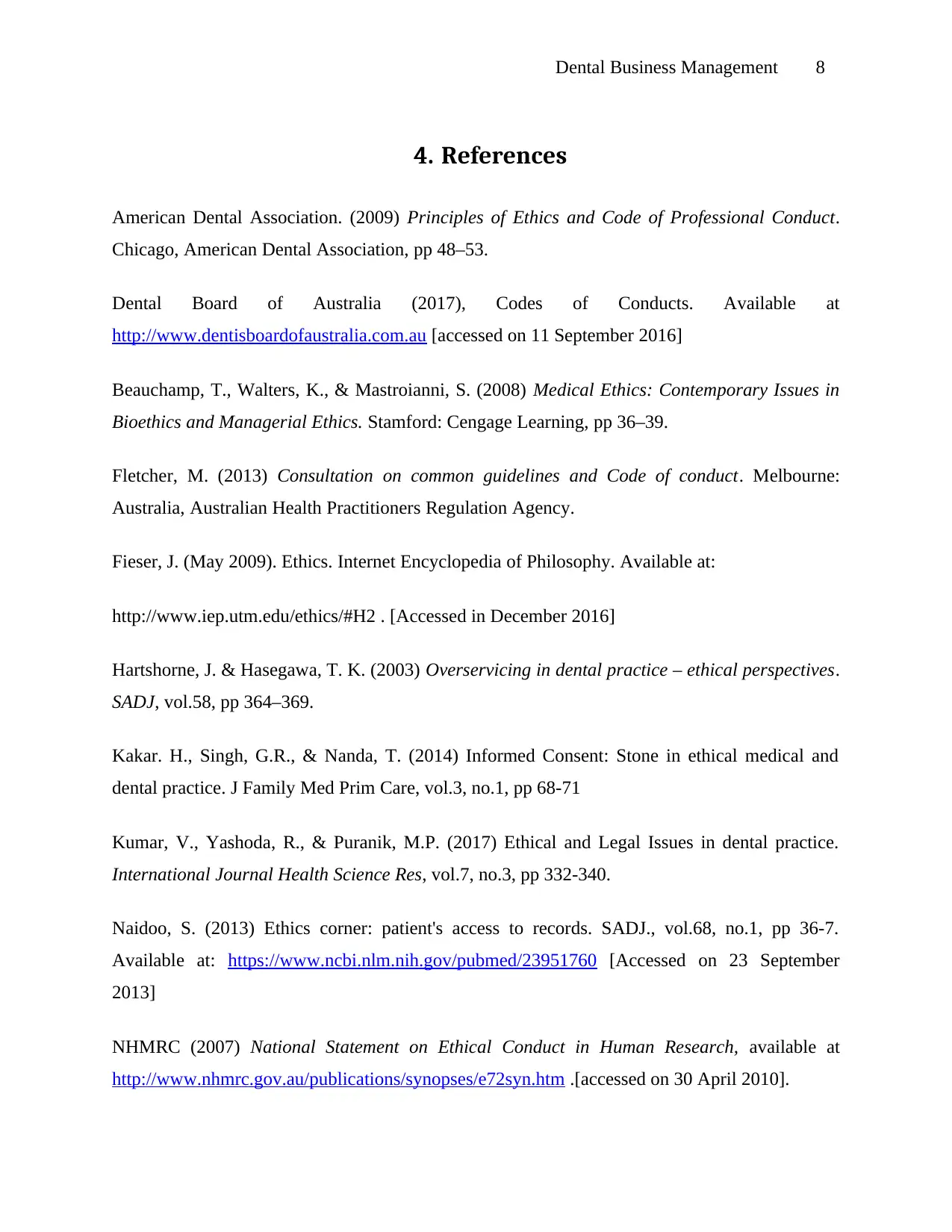
Dental Business Management 8
4. References
American Dental Association. (2009) Principles of Ethics and Code of Professional Conduct.
Chicago, American Dental Association, pp 48–53.
Dental Board of Australia (2017), Codes of Conducts. Available at
http://www.dentisboardofaustralia.com.au [accessed on 11 September 2016]
Beauchamp, T., Walters, K., & Mastroianni, S. (2008) Medical Ethics: Contemporary Issues in
Bioethics and Managerial Ethics. Stamford: Cengage Learning, pp 36–39.
Fletcher, M. (2013) Consultation on common guidelines and Code of conduct. Melbourne:
Australia, Australian Health Practitioners Regulation Agency.
Fieser, J. (May 2009). Ethics. Internet Encyclopedia of Philosophy. Available at:
http://www.iep.utm.edu/ethics/#H2 . [Accessed in December 2016]
Hartshorne, J. & Hasegawa, T. K. (2003) Overservicing in dental practice – ethical perspectives.
SADJ, vol.58, pp 364–369.
Kakar. H., Singh, G.R., & Nanda, T. (2014) Informed Consent: Stone in ethical medical and
dental practice. J Family Med Prim Care, vol.3, no.1, pp 68-71
Kumar, V., Yashoda, R., & Puranik, M.P. (2017) Ethical and Legal Issues in dental practice.
International Journal Health Science Res, vol.7, no.3, pp 332-340.
Naidoo, S. (2013) Ethics corner: patient's access to records. SADJ., vol.68, no.1, pp 36-7.
Available at: https://www.ncbi.nlm.nih.gov/pubmed/23951760 [Accessed on 23 September
2013]
NHMRC (2007) National Statement on Ethical Conduct in Human Research, available at
http://www.nhmrc.gov.au/publications/synopses/e72syn.htm .[accessed on 30 April 2010].
4. References
American Dental Association. (2009) Principles of Ethics and Code of Professional Conduct.
Chicago, American Dental Association, pp 48–53.
Dental Board of Australia (2017), Codes of Conducts. Available at
http://www.dentisboardofaustralia.com.au [accessed on 11 September 2016]
Beauchamp, T., Walters, K., & Mastroianni, S. (2008) Medical Ethics: Contemporary Issues in
Bioethics and Managerial Ethics. Stamford: Cengage Learning, pp 36–39.
Fletcher, M. (2013) Consultation on common guidelines and Code of conduct. Melbourne:
Australia, Australian Health Practitioners Regulation Agency.
Fieser, J. (May 2009). Ethics. Internet Encyclopedia of Philosophy. Available at:
http://www.iep.utm.edu/ethics/#H2 . [Accessed in December 2016]
Hartshorne, J. & Hasegawa, T. K. (2003) Overservicing in dental practice – ethical perspectives.
SADJ, vol.58, pp 364–369.
Kakar. H., Singh, G.R., & Nanda, T. (2014) Informed Consent: Stone in ethical medical and
dental practice. J Family Med Prim Care, vol.3, no.1, pp 68-71
Kumar, V., Yashoda, R., & Puranik, M.P. (2017) Ethical and Legal Issues in dental practice.
International Journal Health Science Res, vol.7, no.3, pp 332-340.
Naidoo, S. (2013) Ethics corner: patient's access to records. SADJ., vol.68, no.1, pp 36-7.
Available at: https://www.ncbi.nlm.nih.gov/pubmed/23951760 [Accessed on 23 September
2013]
NHMRC (2007) National Statement on Ethical Conduct in Human Research, available at
http://www.nhmrc.gov.au/publications/synopses/e72syn.htm .[accessed on 30 April 2010].
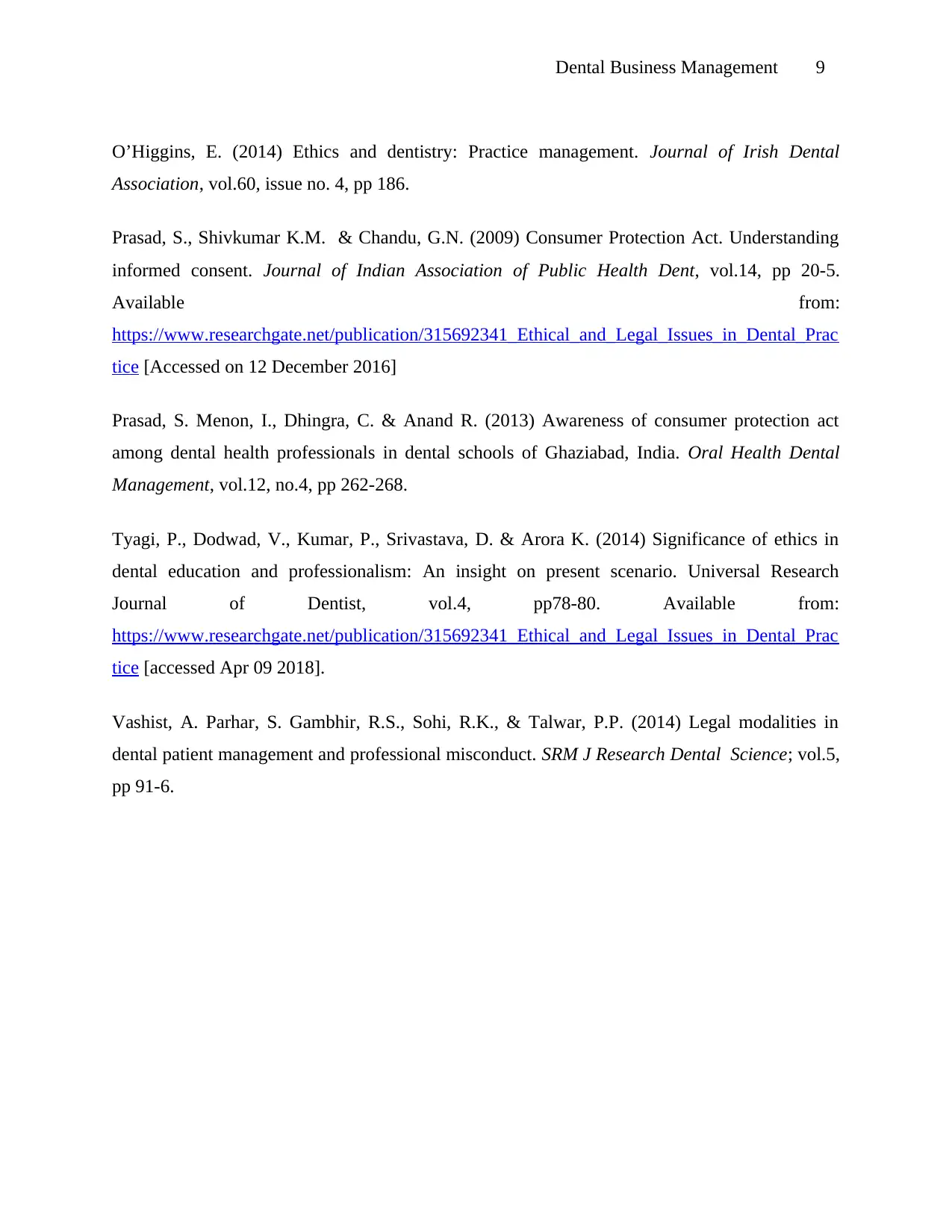
Dental Business Management 9
O’Higgins, E. (2014) Ethics and dentistry: Practice management. Journal of Irish Dental
Association, vol.60, issue no. 4, pp 186.
Prasad, S., Shivkumar K.M. & Chandu, G.N. (2009) Consumer Protection Act. Understanding
informed consent. Journal of Indian Association of Public Health Dent, vol.14, pp 20-5.
Available from:
https://www.researchgate.net/publication/315692341_Ethical_and_Legal_Issues_in_Dental_Prac
tice [Accessed on 12 December 2016]
Prasad, S. Menon, I., Dhingra, C. & Anand R. (2013) Awareness of consumer protection act
among dental health professionals in dental schools of Ghaziabad, India. Oral Health Dental
Management, vol.12, no.4, pp 262-268.
Tyagi, P., Dodwad, V., Kumar, P., Srivastava, D. & Arora K. (2014) Significance of ethics in
dental education and professionalism: An insight on present scenario. Universal Research
Journal of Dentist, vol.4, pp78-80. Available from:
https://www.researchgate.net/publication/315692341_Ethical_and_Legal_Issues_in_Dental_Prac
tice [accessed Apr 09 2018].
Vashist, A. Parhar, S. Gambhir, R.S., Sohi, R.K., & Talwar, P.P. (2014) Legal modalities in
dental patient management and professional misconduct. SRM J Research Dental Science; vol.5,
pp 91-6.
O’Higgins, E. (2014) Ethics and dentistry: Practice management. Journal of Irish Dental
Association, vol.60, issue no. 4, pp 186.
Prasad, S., Shivkumar K.M. & Chandu, G.N. (2009) Consumer Protection Act. Understanding
informed consent. Journal of Indian Association of Public Health Dent, vol.14, pp 20-5.
Available from:
https://www.researchgate.net/publication/315692341_Ethical_and_Legal_Issues_in_Dental_Prac
tice [Accessed on 12 December 2016]
Prasad, S. Menon, I., Dhingra, C. & Anand R. (2013) Awareness of consumer protection act
among dental health professionals in dental schools of Ghaziabad, India. Oral Health Dental
Management, vol.12, no.4, pp 262-268.
Tyagi, P., Dodwad, V., Kumar, P., Srivastava, D. & Arora K. (2014) Significance of ethics in
dental education and professionalism: An insight on present scenario. Universal Research
Journal of Dentist, vol.4, pp78-80. Available from:
https://www.researchgate.net/publication/315692341_Ethical_and_Legal_Issues_in_Dental_Prac
tice [accessed Apr 09 2018].
Vashist, A. Parhar, S. Gambhir, R.S., Sohi, R.K., & Talwar, P.P. (2014) Legal modalities in
dental patient management and professional misconduct. SRM J Research Dental Science; vol.5,
pp 91-6.
⊘ This is a preview!⊘
Do you want full access?
Subscribe today to unlock all pages.

Trusted by 1+ million students worldwide
1 out of 9
Related Documents
Your All-in-One AI-Powered Toolkit for Academic Success.
+13062052269
info@desklib.com
Available 24*7 on WhatsApp / Email
![[object Object]](/_next/static/media/star-bottom.7253800d.svg)
Unlock your academic potential
Copyright © 2020–2025 A2Z Services. All Rights Reserved. Developed and managed by ZUCOL.





